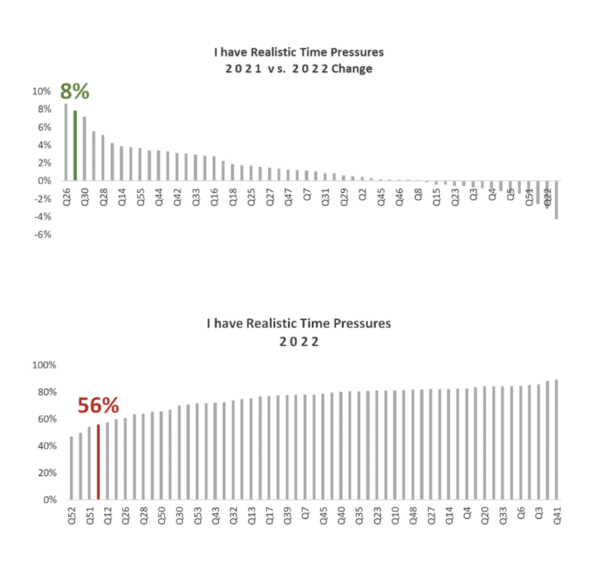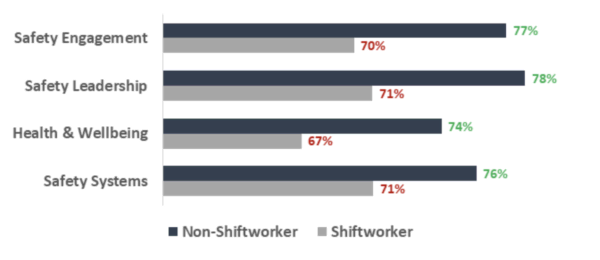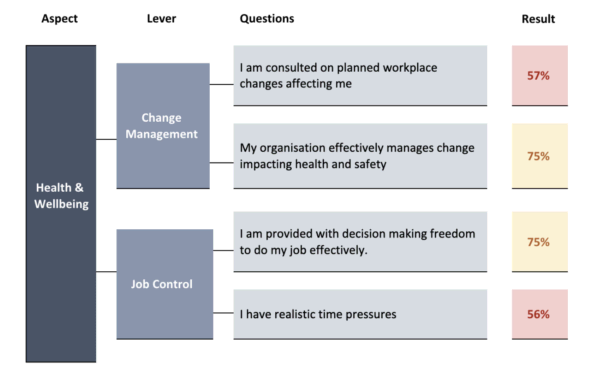Health and Safety Blind Spots in Workplace
A study by FEFO Consulting found that workplace health and safety is the lowest-scoring area in terms of workplace well-being, with unrealistic time pressures and poor change management consultation being two of the biggest blind spots.
New Research Findings on Workplace Well-Being

A company is often like a well-oiled machine. It requires a service every so often to ensure everything is in working order and you can identify blind spots.
On that note, each year, FEFO reviews Health and Safety Index benchmark data to understand trends, hotspots, and insights and provide feedback to health and safety professionals on how they can improve their programs.
FEFO’s Health and Safety Index tool is a simple online survey enabling organizations to measure health and safety performance, focus, and act on improvements that matter.
Benchmark Results Show Low Scores for Workplace Health and Well-Being
Overall Health and Safety Index results from 2021 versus 2022 were relatively stable, increasing by one percent.
Notwithstanding this, there were specific areas that had much larger shifts, and we continued to see certain trends continue year-on-year from 2020.
Of our four aspects, workplace health and well-being continued to be the lowest-scoring area.
| Aspects | 2021 | 2022 |
| Safety Systems | 75% | 76% |
| Health & Well-being | 73% | 74% |
| Safety Leadership | 77% | 78% |
| Safety Engagement | 75% | 77% |
Based on the health and well-being benchmark questions, realistic time pressures (56 percent) and change management consultation (57 percent) were the poorest results.
One of the benefits of evaluating several health and safety metrics is understanding interdependencies. For example:
- Time Pressures: Do unrealistic time pressures impact mental health and/or safety shortcuts?
- Change Management: Do clear communication and expectations help with employee engagement?
When identifying trends, we can see worker realistic time pressures improved by eight percent from 2021. Despite this improvement, time pressure is the fourth worst result of 55 questions.

Negative Trends in Workplace Well-Being
Accessible workplace health and safety procedures, clear, and easy-to-use Workplace Health and Safety (WHS) processes were the biggest loser in 2022. As technology improves, expectations of a new norm also shift. The User Experience (UX) of software inside a workplace and the outside are independent. Not all workplaces have the same capabilities, capacities, and resources as Apple and Commonwealth Bank, as merely a few examples. Despite this potential gap, it’s worth organizations acknowledging the need to adapt and cater to shifting expectations on accessible, clear, and easy-to-use WHS processes.
Focus Group: Shift Workers Versus Non-Shift Workers
When presenting benchmark data, it’s important to consider not just how this impacts the individual, but also how this impacts different groups within the workplace. Shift workers are typically the minority in many organizations; Health and Safety Index results are consistently lower with shift workers.

There is also a drastic difference between sleep for shift workers and non-shift workers:
“In the last four weeks, work has negatively impacted my ability to sleep,” reported 39 percent of shift workers and 55 percent of non-shift workers.
Levers for Action
The Health & Safety Index has been designed to provide “levers” for action. We provide approximately 12 possible levers for action to provide guidance on strategic choices.
The example below provides an example of two levers related to workplace health and well-being. Often, it’s a balance of recognizing higher positive scores, versus lower results needing attention.
In this example, we would recommend addressing change consultation and realistic time pressures. This is often best achieved by leveraging higher safety leadership scores (positive results) as an enabler for improvement.

The Health and Safety Index enables organizations to understand correlations and the relationship between data sets. This provides guidance on actions for improvement that potentially enables the best Return on Investment (ROI).
Psychosocial Levers for Action
Based on our 2022 benchmark data analysis, we recommend four core areas to improve health and well-being in the workplace:
- Job control
- Change management
- Supportive environment
- Values and beliefs
Learn more about how to improve health and well-being in the workplace by watching our webinar—Blind Spots and Levers for Action—here with SAI360, Kasa Consulting, and FEFO.
Together, we discuss:
- Trends and hotspots in employee health and safety programs
- Safety performance measurements
- Insights to help you discover areas of focus and initiate improvements that matter
- How available digital tools drive workers’ engagement and change management needs
Watch our webinar—Blind Spots and Levers for Action—here.
By Mark Wright, Director, FEFO Consulting



